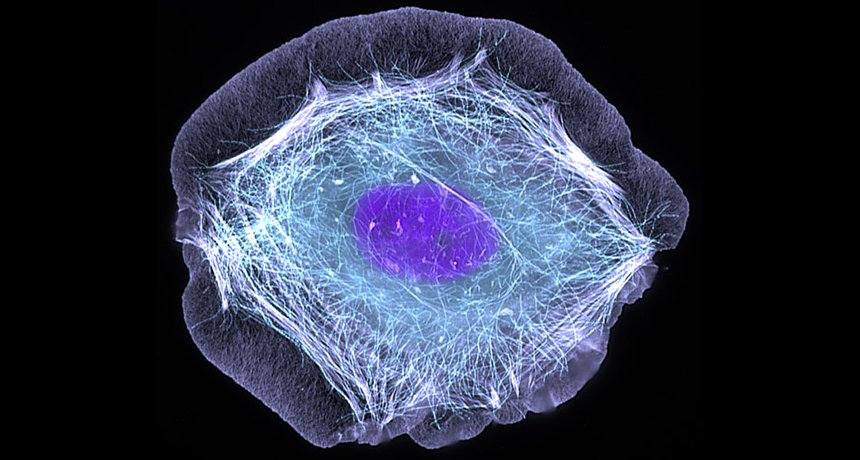‘Nanostraws’ safely sneak a peek inside cells
Scientists can use them to sample a cell’s contents — even repeatedly — without causing damage

Cells hold the secrets of life. This is a skin cell, which not only protects the body but also heals wounds and prevents infections. Now researchers have found a new way to see what goes on inside cells.
Torsten Wittmann, University of California, San Francisco
Cells hold the secrets of life. Inside a cell are the proteins, genetic information and other parts that keep life going. Naturally, scientists want to learn more about a cell’s inner workings by peeking under the hood, so to speak. That’s a challenging task, but researchers in Palo Alto, California have just unveiled a new way to look inside a cell. Their method is simpler and less destructive than others.
Ian Wong describes the new technique as “elegant.” An engineer at Brown University in Providence, R.I., he was not involved in developing the new approach. But he’s excited that it will let scientists probe changes in an individual cell. “You can get a snapshot of what the cell is doing over time without killing it,” he explains.
Nicholas Melosh is an engineer at Stanford University. He likens his team’s new process to drawing blood with needles. Only in their case, they use nano-sized tubes — think of them as ultra-tiny drinking straws. But these straws are so small you’d have to bundle hundreds of them together to be as wide as a thin human hair.
Being so small, they can pierce through a cell’s outer wall without harming it. In much same way, your doctor can stick a needle into your arm to extract a bit of blood for analysis. These straws instead slurp out tiny bits of a cell’s fluids, without causing damage.
These nanostraws can therefore become a portal to what’s inside any cell. “You take a little bit of material directly out and analyze it,” Melosh says. This will allow scientists to peak into cells as they grow, change, divide and die. Studying that material, “you can tell a lot about the health of the cell,” he notes.
Melosh’s team described its new technology March 7 in the Proceedings of the National Academy of Sciences.
What led to the innovation
Today, scientists tend to study cells using several different techniques. They can look at them from the outside, using microscopes and other tools. They also can analyze what is inside them. The usual way is to lyse the cell, or break it open so that its contents spill out. To give up the cell’s secrets, this way, the cell also has to die. Another, more complicated technique for viewing a cell’s contents involves using glowing dyes. Some of these will light up when certain changes occur in a cell.
Scientists would like to see directly what’s in a cell — but without killing it.
Six years ago, Melosh’s team found a way to use nanostraws to deliver genetic material to the inside of a cell. (Other scientists are looking for ways to use that technology to put drugs directly into cells.) About two years ago, the Stanford team wondered if the straws also could be used to take out material. As it turned out, removing stuff from a cell is much harder than putting stuff in. But after years of trial and error, they discovered how to do it.
And here’s the trick. Researchers grow, or culture, cells right on top of a set of straws. The straws poke through the outermost membrane of the cells. This lets molecules pass through the straw and out of the cell. From there, the scientists can study the material that leaks out.
The approach doesn’t let scientists study cells inside the body. But it does give them valuable information about the mysteries of how a cell works. Scientists have long used lab-grown cells to better understand natural behaviors and changes in cells.
The Stanford researchers tested their approach over and over and over. They tested human heart tissue and brain cells, as well as other cell types. Their experiments showed that nanostraws worked as well as lysing for learning what proteins and other molecules exist inside a cell. But unlike lysed ones, these cells continue to live.
Melosh wanted to get the tool right. But he also wanted other researchers to be able to use it. So he and his collaborators built a device that other researchers can use to make nanostraws in their own laboratories.
In the future
The new nanostraws may become valuable tools for medicine. Scientists could use them to study stem cells, for example. These cells are like blank slates. They can differentiate. This means these cells can mature into any other type. The same stem cells might grow up to be a brain or muscle or bone cell. Researchers are studying stem cells as a possible treatment for a range of conditions.
For example, such cells might help repair a broken heart. When a person suffers a heart attack or heart disease, the heart tissue becomes damaged. That damage can kill heart cells and lead to a poorly performing pump for the body’s blood supply. Because stem cells can turn into new heart cells, scientists are looking at ways to inject them into damaged hearts. They hope the stem cells will grow into new, healthy tissue and repair any damage.
But differentiation is mysterious. Scientists don’t fully understand how it happens. Nanostraws could let them watch this transformation. Scientists can use nanostraws to sample the same stem cell at different times. By comparing those samples, they can see what’s changing over time — kind of like combining still images to form a movie. And with that information, scientists might help to design new stem-cell treatments.
This is one in a series presenting news on technology and innovation, made possible with generous support from the Lemelson Foundation.







